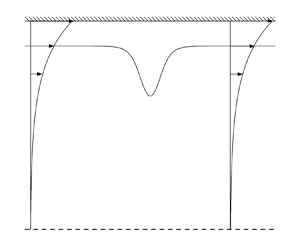Article contents
High-level Green–Naghdi model for large-amplitude internal waves in deep water
Published online by Cambridge University Press: 03 June 2024
Abstract

In this paper, a high-level Green–Naghdi (HLGN) model for large-amplitude internal waves in a two-layer fluid system, where the upper-fluid layer is of finite depth and the lower-fluid layer is of infinite depth, is developed under the rigid-lid free-surface approximation. The equations of the present HLGN model follow Euler's equations under the sole assumption that the horizontal and vertical velocity distributions along the vertical column are presented by known shape functions for each layer. The linear dispersion relations of the HLGN model for different levels are presented and compared with those obtained by other strongly nonlinear models for deep water, including the fully nonlinear models that include the dispersion effects  $O(\mu )$ (where
$O(\mu )$ (where  $\mu$ is the ratio of the upper-fluid layer depth to a typical wavelength) derived by Choi & Camassa (Phys. Rev. Lett., vol. 77, 1996, pp. 1759–1762) and
$\mu$ is the ratio of the upper-fluid layer depth to a typical wavelength) derived by Choi & Camassa (Phys. Rev. Lett., vol. 77, 1996, pp. 1759–1762) and  $O(\mu ^2)$ derived by Debsarma et al. (J. Fluid Mech., vol. 654, 2010, pp. 281–303). It is shown that the HLGN model has a wider application range than other models. Solutions of travelling large-amplitude internal solitary waves in the absence and presence of background shear-current are then investigated by using the HLGN model. For the no-current cases, results obtained by the HLGN model show better agreement with Euler's solution on wave profile, velocity profile at the maximum interface displacement and wave speed compared with those obtained by other models. For the background shear-current cases, results obtained by the HLGN model also show good agreement with those obtained by solving the Dubreil-Jacotin–Long equation.
$O(\mu ^2)$ derived by Debsarma et al. (J. Fluid Mech., vol. 654, 2010, pp. 281–303). It is shown that the HLGN model has a wider application range than other models. Solutions of travelling large-amplitude internal solitary waves in the absence and presence of background shear-current are then investigated by using the HLGN model. For the no-current cases, results obtained by the HLGN model show better agreement with Euler's solution on wave profile, velocity profile at the maximum interface displacement and wave speed compared with those obtained by other models. For the background shear-current cases, results obtained by the HLGN model also show good agreement with those obtained by solving the Dubreil-Jacotin–Long equation.
Information
- Type
- JFM Papers
- Information
- Copyright
- © The Author(s), 2024. Published by Cambridge University Press
References
- 1
- Cited by


